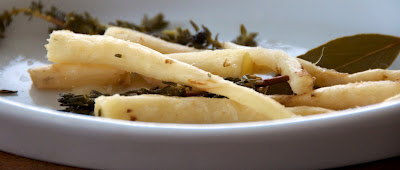Fall Foraging

Several of the prepper and foraging FB groups I inhabit are talking about the Fall bounty of wild eatables. I don't have any where wild close that I can yet, nor have I categorized the flowers my sister has planted over the years to see which ones I can add to the pot but I will next Spring and perhaps add some of my own that are eatable. In the mean time I wondered what everyone is eating?
I saw a post which lead me to this article:
https://fat-of-the-land.blogspot.com/2012/07/wild-salsify.html
Not familiar with the plant but that plate looks delicious.

Kay Robison
Mon, 11/08/2021 - 07:38
Permalink
Salsify
It is a delicious root vegetable and the domesticated version is as easy to grow as carrots. I grow some every year. The wild version that I know doesn't produce such a generous root, but perhaps even small ones are as good as the domesticated version.
ClareBroommaker
Wed, 11/10/2021 - 00:17
Permalink
Salsify, oyster plant is
Salsify, oyster plant is delicious, but I've never seen it growing around here (same environs as David Trammel). When I met my son's in-laws in Wisconsin, I saw salsify growing everywhere around their farm! You could spot it by its purpley chicory-like flower or its large, stout (almost woody) seedhead that also looks like a giant dandelion puff ball. I asked my daughter-in-law if people gather it for eating. She did not know, but she asked her grandfather who said that they used to do so....If I lived around there, I would not only harvest the roots but also the lovely seedheads for dry bouquets. Have tried black salsify as a garden vegetable, but my soil was not yet soft enough, I think, so the roots were stringy. Probably I could grow it better nowadays after years of soil improvement. My guess is that in gardens or in the wild it would be best in soft, possibly sandy soils. They do indeed have excellent sandy potato growing soil in that part of Wisconsin where I saw so much salsify.
I mentioned the other day that plantain, Plantago major, looks good for harvest right now. Lots of new growth leaves that are less fibrous and flawless looking. I'm seeing less of the narrow leaf plantain, but, yes, it does have new growth too.
I think this would be a good time to forage sunchokes while you can still spot them from their stalks and drooping, frost stricken leaves.
I've been surprised to see some kind of purple flowering mallow in full bloom the last couple weeks. I'm not sure what kind it is, but mallows have some use both as food and in alternative medicine. Being in full bloom, the plants are generally very healthy looking right now, so I imagine it is a good time to forage from them.
How about nuts and tree fruit? I think we are just past time for getting pawpaws. There would be black walnut, butternut, and if you're lucky, maybe still some crab apples. There might still be a late bearing native plum, oh and definitely autumn olives. Acorns are falling, if you care to go through the trouble of processing those. There might be rose hips to be found. The chestnuts were falling as early as mid-September, but I don't see any now.
For those who have a wild place where they can dig, I see no problem with taking sassafras roots in fall. Mmm, I love the smell of sassafras. Might have to see if anyone at the farmer's market near down town has any to sell.
Wild onions/garlic are growing again, so you can find them.
Lotus roots! Some people harvest them in our biggest city park, though one of the prime ponds has been filled in.
And, uh, er, morningglory seeds (medicinal?) are ready or soon ready.